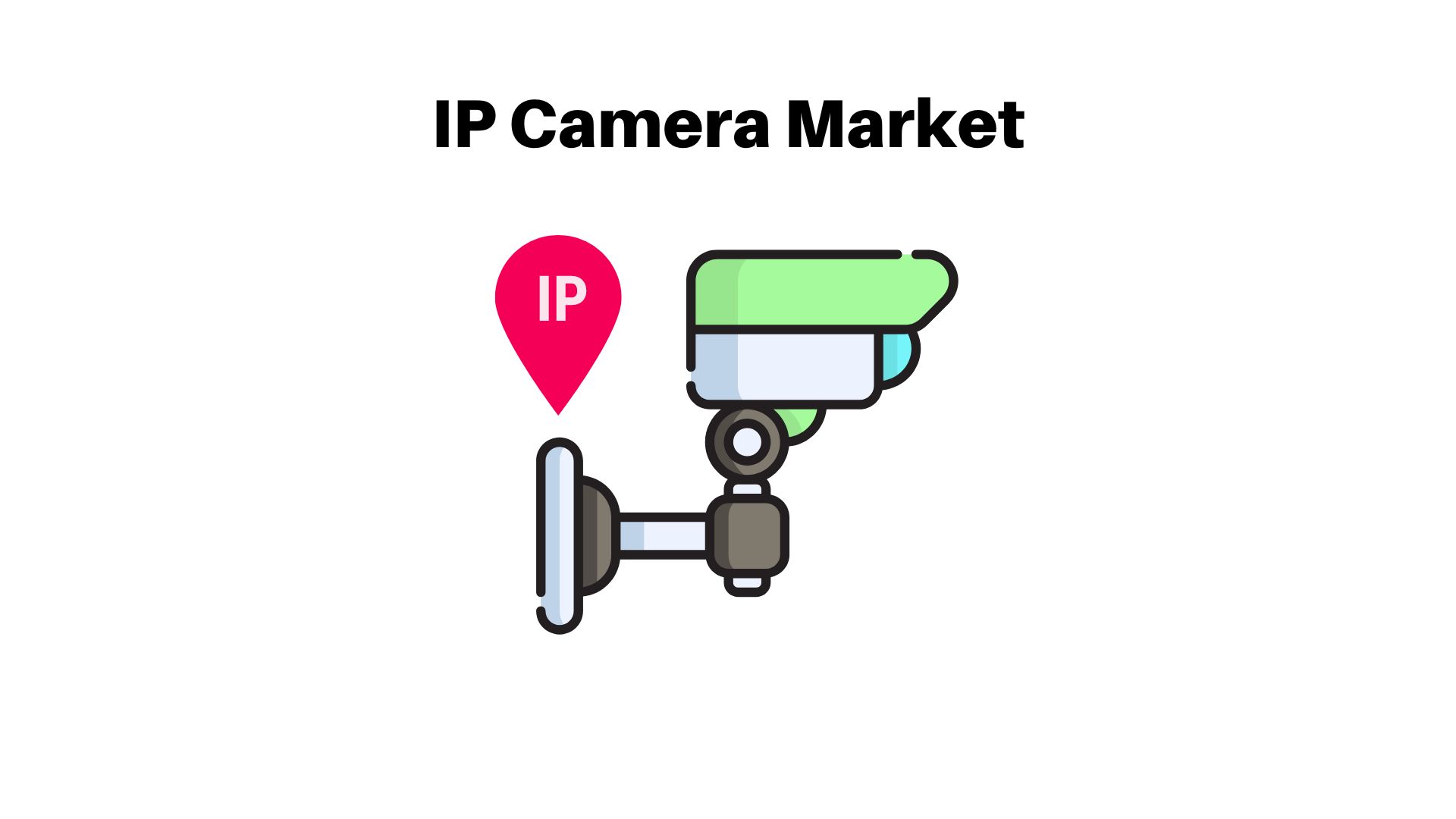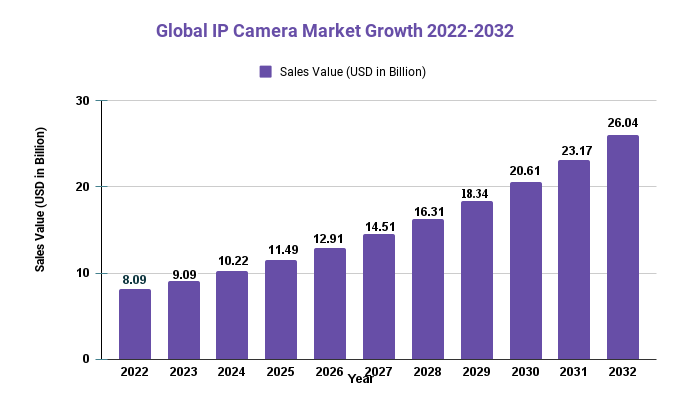The Global IP Camera Market is forecast to reach a value of USD 26.04 billion by 2032

Page Contents
Market Overview
Published Via 11Press: In 2022, the global IP Camera Market was valued at USD 8.09 billion and is forecast to reach a value of USD 26.04 billion by 2032, growing at a compound annual growth rate (CAGR) of 12.4% from 2022-2032.
IP cameras are digital video recording devices that use internet protocol technology to transmit and receive video over the internet or a computer network. These cameras offer superior image quality, remote access, advanced features like motion detection, facial recognition, and analytics for more efficient video surveillance.
The IP camera market is driven by several factors, such as rising demand for video surveillance in retail, healthcare and transportation; advances in technology like 4K resolution and artificial intelligence-based visual analytics; and the need for enhanced security measures.
At present, North America leads the market for IP cameras, followed by Europe. Asia Pacific will experience rapid growth over the forecast period due to increased demand for video surveillance in China, India and Japan.
Would you like to access the statistical information, graphs, and key players' tactics? click here| https://market.us/report/ip-camera-market/request-sample
Key Takeaways
- Growing Demand for Video Surveillance: The IP Camera market is being driven by rising demand in various sectors such as retail, healthcare, and transportation due to the need for improved security measures.
- Advancements in technology: The adoption of 4K resolution and artificial intelligence-based video analytics is driving growth within the IP Camera market. These advances enable more sophisticated video surveillance and analysis.
- Market Size: In 2020, the IP Camera market was valued at $6.4 billion and is projected to reach $16.6 billion by 2028 at a compound annual growth rate (CAGR) of 12.4% from 2021-2028.
- Regional Growth: North America is currently the leading market for IP cameras, followed by Europe and Asia Pacific. Over the forecast period, however, Asia Pacific is expected to experience the fastest-growing region in terms of revenue.

Regional Snapshot
- North America: North America is currently the leading market for IP cameras, driven by rising demand in sectors such as retail, healthcare and transportation. The United States accounts for much of this growth due to its established key players and rapid adoption of video surveillance solutions.
- Europe: Europe is the second-largest market for IP cameras, due to an increasing need for video surveillance in various applications such as government, banking and retail. The United Kingdom, Germany, France and Italy are the major players on this front.
- Asia Pacific: Over the forecast period, Asia Pacific is predicted to experience the fastest growth rate in video surveillance demand due to growing needs in countries like China, India and Japan. This growth can also be attributed to advances such as 4K resolution and AI-based video analytics.
- Rest of World: This segment includes Latin America, the Middle East and Africa. The market growth in these regions can be attributed to an increasing demand for video surveillance systems across various applications such as commercial and industrial sectors.
Drivers
- Growing Demand for Video Surveillance: With security and safety becoming more of a focus in sectors like retail, healthcare, and transportation, video surveillance has become an increasingly popular solution. IP cameras boast advanced features like remote access, motion detection, and facial recognition that make them ideal candidates for video surveillance applications.
- Progress in Technology: The adoption of 4K resolution and artificial intelligence-based video analytics are driving growth within the IP Camera market. These developments enable more sophisticated surveillance methods, providing enhanced security and safety measures.
- Increased Adoption of Internet of Things (IoT): The growing acceptance of IoT is fuelling growth in the IP Camera market. IP cameras can easily be integrated with other IoT devices and platforms, enabling data sharing and real-time monitoring capabilities.
- Government Initiatives: Governments around the world are investing in surveillance systems to enhance public safety and reduce crime rates. This has spurred growth within the IP Camera market, particularly within public safety and law enforcement applications.
- Cost Efficiency: IP cameras are more cost-effective than traditional analog cameras due to the need for less cabling and hardware, making them an attractive option for businesses and organizations looking for budget-conscious video surveillance solutions.
Before obtaining this research, find out more about it or ask any questions you have at| https://market.us/report/ip-camera-market/#inquiry
Restraints
- High Installation and Upkeep Costs: Although IP cameras are more cost-effective than their analog counterparts, the initial installation fees can be high. Furthermore, ongoing maintenance fees can accumulate over time, particularly for larger installations.
- Cybersecurity Concerns: IP cameras are vulnerable to cyberattacks like hacking or data breaches that could compromise sensitive information and affect privacy. This poses a major problem for businesses and organizations that depend on video surveillance for security purposes.
- Lack of Skilled Professionals: IP cameras require skilled personnel for installation, maintenance and operation. This lack of talent can present a major hurdle for businesses and organizations looking to utilize IP cameras.
- Legal and Privacy Concerns: IP cameras can raise legal and privacy issues, particularly in public places. Businesses and organizations must abide by relevant laws and regulations regarding video surveillance – an often complex and time-consuming process.
- Limited Compatibility: IP cameras may not be compatible with existing video surveillance systems, which could present a major hurdle for businesses and organizations that have already invested in traditional analog cameras and infrastructure.
Opportunities
- Cloud-Based Video Surveillance Gaining Popularity: Cloud-based video surveillance is becoming more and more popular due to its scalability, adaptability, and cost efficiency. IP cameras can easily be integrated with cloud platforms, offering vendors in the IP Camera market an opportunity to offer cloud-based video surveillance solutions.
- Rising Demand for Home Security: The growing concern over home security and safety is driving demand for IP cameras in residential markets. This presents vendors with an opportunity to offer cost-effective yet user-friendly IP camera solutions for home monitoring purposes.
- Integration with Artificial Intelligence and Machine Learning: Combining IP cameras with artificial intelligence and machine learning technologies can offer advanced video analytics, real-time monitoring capabilities, and presents vendors in the IP Camera market with an opportunity to offer more sophisticated and intelligent video surveillance solutions.
- Expansion of Smart City Initiatives: Governments around the world are investing in smart city initiatives, which include video surveillance as a major element. This presents an opportunity for vendors in the IP Camera market to provide solutions related to smart city video surveillance systems.
- 5G network development: 5G networks promise quicker and more reliable connectivity, giving IP cameras a competitive advantage. Vendors now have the opportunity to provide high-speed and low latency IP camera systems across numerous industries.
Challenges
- Competition from Traditional Analog Cameras: Although IP cameras offer several advantages over analog cameras, such as higher resolution and remote access, analog cameras still hold a significant market share. This presents vendors in the IP Camera market with an uphill battle to convince customers to switch over to IP cameras.
- Price Sensitivity: Price sensitivity remains a significant challenge in the IP Camera market, particularly in price-sensitive regions such as Asia-Pacific and Latin America. Vendors must offer affordable yet competitive prices to remain competitive in these regions.
- Limited Bandwidth and Storage Capacity: IP cameras require high bandwidth and storage capacity, which may pose a challenge for businesses and organizations with limited resources. This has the potential to hinder the adoption of IP cameras in certain sectors.
- Cybersecurity Threats: Cybersecurity risks pose a significant challenge for the IP Camera market, as IP cameras are vulnerable to hacking and data breaches. Vendors must ensure their IP cameras are secure and compliant with relevant cybersecurity regulations and standards.
- Interoperability Issues: IP cameras may not be interoperable with other video surveillance systems, which could limit their adoption in certain sectors. This presents a major obstacle for businesses and organizations that have already invested in existing video surveillance infrastructure.
Recent Developments
- Oct-2022: Panasonic Connect North America has recently added SMPTE2110 compatibility and IP/networked capabilities to their professional PTZ and studio camera lineup. These enhancements enable more dynamic multi-cam productions and studios to expand their connected workflows.
- Sep-2022: Sony Electronics unveiled the ILME-FR7, an E-mount interchangeable lens camera to its Cinema Line. Boasting a full frame image sensor and integrated pan/tilt/zoom (PTZ) functionality, this camera provides cinematic quality visuals while offering efficient multi-camera workflow support and versatile connectivity options.
Key Market Segments
Type
- Centralized IP Cameras
- Decentralized IP Cameras
Application
- Chemical Industry
- Pharmaceutical Industry
Key Market Players
- Hikvision
- Axis Communications
- Panasonic
- Dahua
- Bosch Security Systems
- Sony
- Samsung
- Avigilon
- Pelco by Schneider Electric
- Honeywell
- Mobotix
- GeoVision
- Belkin
- NetGeat
- Vivotek
- D-Link
- Arecont Vision
- Wanscam
- Toshiba
- GOSCAM
Report Scope
| Report Attribute | Details |
| The market size value in 2022 | USD 8.09 Bn |
| Revenue forecast by 2032 | USD 26.04 Bn |
| Growth Rate | CAGR Of 12.4% |
| Regions Covered | North America, Europe, Asia Pacific, Latin America, and Middle East & Africa, and Rest of the World |
| Historical Years | 2017-2022 |
| Base Year | 2022 |
| Estimated Year | 2023 |
| Short-Term Projection Year | 2028 |
| Long-Term Projected Year | 2032 |
Frequently Asked Questions
Q: What is the current market size of the IP Camera Market?
A: The IP Camera Market was valued at USD 8.09 billion in 2022, according to a report by Market.us. The market is expected to grow at a compound annual growth rate (CAGR) of 12.4% from 2022 to 2032, reaching a value of USD 26.04 billion by 2032.
Q: Who are the key players in the IP Camera Market?
A: Some of the key players in the IP Camera Market include Hikvision, Axis Communications, Panasonic, Dahua, Bosch Security Systems, Sony, Samsung, Avigilon, Pelco by Schneider Electric, Honeywell, Mobotix, GeoVision, Belkin, NetGeat, Vivotek, D-Link, Arecont Vision, Wanscam, Toshiba, GOSCAM.
Q: What segments are covered in the IP Camera Market Report?
A: The Global IP Camera market is segmented based on type (Centralized IP Cameras, Decentralized IP Camera), Application (Chemical Industry, Pharmaceutical Industry) and Geography.
The team behind market.us, marketresearch.biz, market.biz and more. Our purpose is to keep our customers ahead of the game with regard to the markets. They may fluctuate up or down, but we will help you to stay ahead of the curve in these market fluctuations. Our consistent growth and ability to deliver in-depth analyses and market insight has engaged genuine market players. They have faith in us to offer the data and information they require to make balanced and decisive marketing decisions.